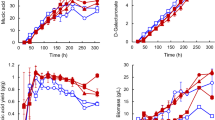Abstract
The growth parameters of Achromobacter sp. Kg 16 (VKM B-2534 D), such as biomass and maximum specific growth rate, depended only on the source of phosphorus in the medium, but not on the carbon source or the presence of growth factors. With glyphosate as a sole phosphorus source, they were still 40–50 % lower than in media supplemented with orthophosphate or other organophosphonate-methylphosphonic acid. At the first time process of glyphosate acetylation and accumulation of acetylglyphosate in culture medium were revealed in this strain. Acetylglyphosate isolated from cultural liquid was identified by mass spectroscopy; its mass spectrum fully corresponded with that of chemically synthesized acetylglyphosate. Even poorer growth was observed in media with acetylglyphosate: although the strain was able to utilize this compound as a sole source of phosphorus, the maximum biomass was still 58–70 % lower than with glyphosate. The presence of acetylglyphosate in culture medium could also hinder the utilization of glyphosate as a phosphorus source. Therefore, the acetylation of glyphosate may be a specific feature of Achromobacter sp. Kg 16 responsible for its poor growth on this compound.



Similar content being viewed by others
References
Bazot S, Lebeau T (2008) Simultaneous mineralization of glyphosate and diuron by a consortium of three bacteria as free-and/or immobilized-cells formulations. Appl Microbiol Biotechnol 77:1351–1358
Castle LA, Siehl DL, Gorton R, Patten PA, Chen YH, Bertain S, Cho H-J, Duck N, Wong J, Liu D, Lassner MW (2004) Discovery and directed evolution of a glyphosate tolerance gene. Science 304:1151–1154
Dick RE, Quinn JP (1995) Glyphosate-degrading isolates from environmental samples: occurrence and pathways of degradation. Appl Microbiol Biotechnol 43:545–550
Ermakova IT, Shushkova TV, Leont’evskii AA (2008) Microbial degradation of organophosphonates by soil bacteria. Microbiology (Moscow) 77:615–620
Ermakova IT, Kiseleva NI, Shushkova T, Zharikov M, Zharikov GA, Leontievsky AA (2010) Bioremediation of glyphosate-contaminated soils. Appl Microbiol Biotechnol 88:585–594
Errey JC, Blanchard JS (2006) Functional annotation and kinetic characterization of PhnO from Salmonella enterica. Biochemistry 45:3033–3039
Fischer RS, Berry A, Gaines CG, Jensen RA (1986) Comparative action of glyphosate as a trigger of energy drain in eubacteria. J Bacteriol 168:1147–1154
Fitzgibbon JE, Braymer HD (1990) Cloning of a gene from Pseudomonas sp. PG2982 conferring increased glyphosate resistance. Appl Env Microbiol 56:3382–3388
Gard JK, Feng PCC, Hutton WC (1997) Nuclear magnetic resonance timecourse studies of glyphosate metabolism by microbial isolates. Xenobiotica 27:633–644
Hallas LE, Adams WJ, Heitkamp MA (1992) Glyphosate degradation by immobilized bacteria: field studies with industrial wastewater effluent. Appl Environ Microbiol 58:1215–1219
Hess HH, Derr JE (1975) Assay of inorganic and organic phosphorus in the 0.1–5 nanomole range. Anal Biochem 63:607–613
Hove-Jensen B, McSorley FR, Zechel DL (2012) Catabolism and detoxification of 1-aminoalkylphosphonic acids: N-acetylation by the phnO gene product. PLoS ONE 7:1–13
Hove-Jensen B, Zechel DL, Jochimsen B (2014) Utilization of glyphosate as phosphate source: biochemistry and genetics of bacterial carbon-phosphorus lyase. Microbiol Mol Biol Rev 78:176–197
Kamat SS, Williams HJ, Raushel FM (2011) Intermediates in the transformation of phosphonates to phosphate by bacteria. Nature 480:570–573
Leontievsky AA, Ermakova IT, Shushkova TV, Kovaleva MN, Zarikov GA, Kiseleva NI (2009) Organophosphonate-degrading bacterial strain Achromobacter sp. and method of its application for bioremediation of soils. Patent RU 2401298
McGrath JW, Chin JP, Quinn JP (2013) Organophosphonates revealed: new insights into the microbial metabolism of ancient molecules. Nat Rev Microbiol 11:412–419
Quinn JP, Peden JMM, Dick RE (1988) Glyphosate tolerance and utilization by the microflora of soils treated with the herbicide. Appl Microbiol Biotechnol 29:511–516
Schowanek D, Verstraete W (1990) Phosphonate utilization by bacterial cultures and enrichments from environmental samples. Appl Environ Microbiol 56:895–903
Shushkova T, Ermakova I, Leontievsky A (2010) Glyphosate bioavailability in soil. Biodegradation 21:403–410
Shushkova TV, Ermakova IT, Sviridov AV, Leontievsky AA (2012) Biodegradation of glyphosate by soil bacteria: optimization of cultivation and the method for active biomass storage. Microbiology (Moscow) 81:44–50
Siehl DL, Castle LA, Gorton R, Keenan RJ (2007) The molecular basis of glyphosate resistance by an optimized microbial acetyltransferase. J Biol Chem 282:11446–11455
Skachilova S, Ermakova G, Sayapina F, Gromov M, Yurchenko N, Burkov Yu (1996) The method of production of N-acetylglutamic acid. Patent RU 2068408
Sviridov AV, Shushkova TV, Zelenkova NF, Vinokurova NG, Morgunov IG, Ermakova IT, Leontievsky AA (2012) Distribution of glyphosate and methylphosphonate catabolism systems in soil bacteria Ochrobactrum anthropi and Achromobacter sp. Appl Microbiol Biotechnol 97:787–796
Sviridov AV, Shushkova TV, Ermakova IT, Ivanova EV, Leontievsky AA (2014) Glyphosate: safety risks, biodegradation, and bioremediation. In: Cao G, Orru R (eds) Current environmental issues and challenges. Springer Netherlands, Dodrecht, pp 183–192
Zelenkova NF, Vinokurova NG (2008) Analysis of glyphosate and its degradation products by chromatographic methods. J Anal Chem (Moscow) 63:958–961
Author information
Authors and Affiliations
Corresponding author
Ethics declarations
Conflict of interest
The authors declare that they have no competing interests.
Ethical approval
This article does not contain any studies with human participants or animals performed by any of the authors.
Rights and permissions
About this article
Cite this article
Shushkova, T.V., Vinokurova, N.G., Baskunov, B.P. et al. Glyphosate acetylation as a specific trait of Achromobacter sp. Kg 16 physiology. Appl Microbiol Biotechnol 100, 847–855 (2016). https://doi.org/10.1007/s00253-015-7084-1
Received:
Revised:
Accepted:
Published:
Issue Date:
DOI: https://doi.org/10.1007/s00253-015-7084-1




